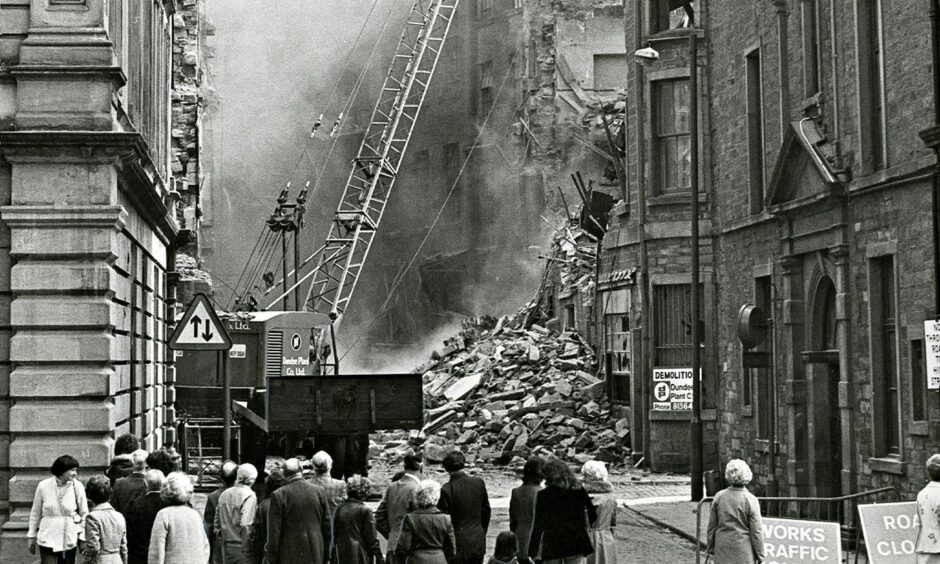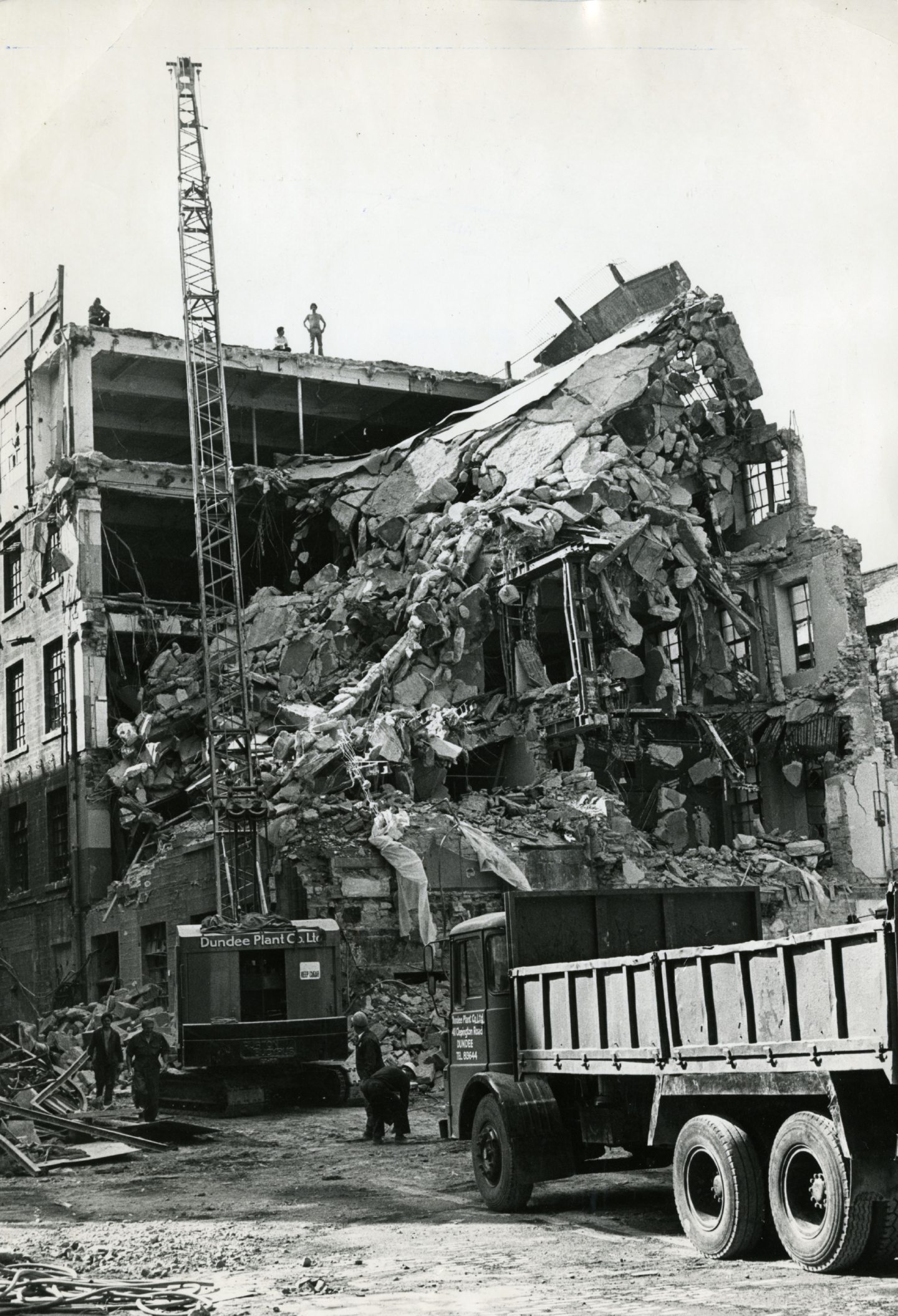
These photographs show the last days of the former Keiller Factory in Albert Square, which was lost to the wrecking ball in 1978.
Generations of Dundonians were aware of the factory’s presence by the mouth-watering aroma wafting over the city centre when sweet-making was in progress.
It was a family firm that grew to become the largest confectionary company in Britain.
Some of our favourite chocolates were once made right on our doorstep.
The Keiller empire started in 1797.
The first premises were in Seagate, and there was a retail shop in Castle Street.
The Keiller produce appears to have been “chip”, a shredded peel marmalade, which differed from the traditional pulped peel, or beaten, marmalade of English tables.
In 1813 one of the leading grocery firms in London gave the marmalade a trial and so successful was the result that a market of almost unlimited potential opened up.
As the popularity of Keiller’s marmalade spread and demand grew, production was moved to a factory in Albert Square around 1856.
The works were greatly extended in 1880, kitting it out with costly modern machinery for the production of Keiller’s cocoa and chocolate.
Phoenix from the flames
The Dundee factory at Albert Square was reduced to ashes in 1900.
An almighty inferno – ignited by an exploding fridge – ripped through Keiller’s premises, causing the equivalent of £10 million of damage in today’s money, and throwing 600 people out of work.
The factory was rebuilt at a cost of £30,000.
In 1947 the company moved part of its production to a wedge of land on Mains Loan, Maryfield, to produce marmalade, jams and Swiss Toblerone.
At this time it was owned by Crosse & Blackwell.
Production at the Albert Square factory that employed 700 people was discontinued in 1971 to concentrate their Dundee manufacturing operations at the Maryfield factory.
It stood empty for seven years.
Planning permission was fully granted for a shopping arcade to replace the old factory with provision for more than 60 shopping units.
The built up nature of the site would make the demolition of the Keiller Factory a tricky proposition for Dundee Plant Company with the factory requiring to be plucked out like a giant tooth.
The firm was awarded a 26-week contract, worth £130,000, to handle the task.
Dundee Plant Company took over the site on April 17 1978 and began work on the decontamination of asbestos before actual demolition work started.
The job would be particularly tricky at the tightly-packed site.
Included in the demolition was a 140ft chimney stack, a 105ft tower block and 10,000 tonnes of rock which would be cleared from the foundations.
“There’s not much room around the street, and the factory is very close to surrounding buildings,” said Ronald Raffan, the firm’s general manager.
“Luckily, though, it’s well away from the milling crowds.
“Where necessary, we will put up scaffolding and protective barriers for safety.
“We will try to keep people as far away as possible; we have the right to close the road and keep pedestrians out of the area.
“We will be using a demolition ball from a crane and hydraulic demolition equipment, mounted on excavators.”
Keiller factory demolition very complex
Eight or nine men, plus machine operators and lorry drivers, were engaged in the demolition, which began in May 1978.
The Keiller Factory took 23 weeks to steadily shrink from the Dundee skyline due to the complexity of the demolition and the high skill that was required.
Now only memories remain.
The Evening Telegraph reported: “No one, except for perhaps a demolition expert, would compare the destruction of a building with the skilled work carried out by a surgeon.
“But a squad of workmen from Dundee Plant Company yesterday completed a task which required almost as high a degree of precision.
“A neat hole has been carved out of what was formerly a tightly-packed group of buildings in the centre of Dundee.
“Where Keiller’s factory stood there is now a vacant site ready for the developers to start a new project.
“At the end of 23 weeks of demolition, made extremely difficult by adjacent and adjoining buildings, the casualty report on the surrounding shops and offices lists only a couple of broken windows and a few missing slates.
“Such was the skill and dexterity displayed by the men from Dundee Plant that not only was the complex work completed without major incident but it was done three weeks ahead of schedule.
“Today the empty site is to be officially handed over to the developers – the Dundee Arcade Property Company Ltd.”
The men worked almost every weekend.
Ronald Raffan explained how they went about removing the old factory without damaging the nearby property.
“We employed an excavator which was fitted with a chain and had a bore where the bucket would normally be,” he said.
“The large ball was also designed so that we could control the angle of movement in every situation.
“Despite the extremely dangerous circumstances, I am happy to report that there was no injury worse than a cut finger.”
Free car parking at vacant plot
Cars started parking at the Albert Square site where the Keiller Factory once stood.
Well over 100 were parked there after the demolition was completed, after landowner Dundee Arcade Property Ltd advertised vehicles were parked free at owners’ risk.
This was taken up by drivers trying to avoid paying 10p-50p to use official parking places.
The free parking didn’t last long.
Work to build the new shopping mall began shortly after the site was cleared.
It took its name from the famous family whose factory had stood before it.
The Keiller Centre opened in 1979.
Iain Flett, from the Friends of Dundee City Archives, said: “Two features from that time continue – New Inn Entry to the west, still cobbled and still one of the oldest streets in Dundee – it predates Reform Street, named after the Reform Act of 1832 – and Rankine’s Court to the east.
“My mother-in-law, now 90, remembers, as a secretary in the 1950s, that, as in Moscow, if you saw a queue outside Keiller’s in Albert Square, then you joined it.
“They apparently sold off ‘imperfect’ batches of chocolate that vanished like snow off a dyke!”
Only memories remain…
The Marmalade on Toast mural by Diane Selbie at New Inn Entry celebrates Keiller’s history by depicting three of the iconic jars which were exported around the world.
The connection with marmalade maker Janet Keiller is also commemorated with a blue plaque at the corner of Castle Street, which forms part of the Dundee Women’s Trail.
Derek Shaw became works director at Keiller’s in 1981 and worked alongside many employees who previously worked in Albert Square before operations closed in 1971.
“When I came to Dundee everyone wanted to tell me stories about Albert Square where the sweet smell of chocolate wafting through the air was impossible to forget,” he said.
“One thing that stood above everything else was the pride everyone took at working there and there was a real sense of community and camaraderie amongst the staff.”
Despite employing nearly 900 people during the 1950s, the Keiller factory’s final owners, Alma Holdings, went bust in March 1992 before the plant was sold off.
The Mains Loan site – like its Albert Square predecessor – was razed to the ground.



















Conversation